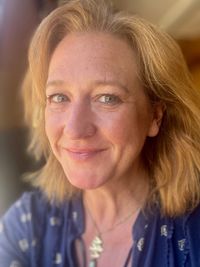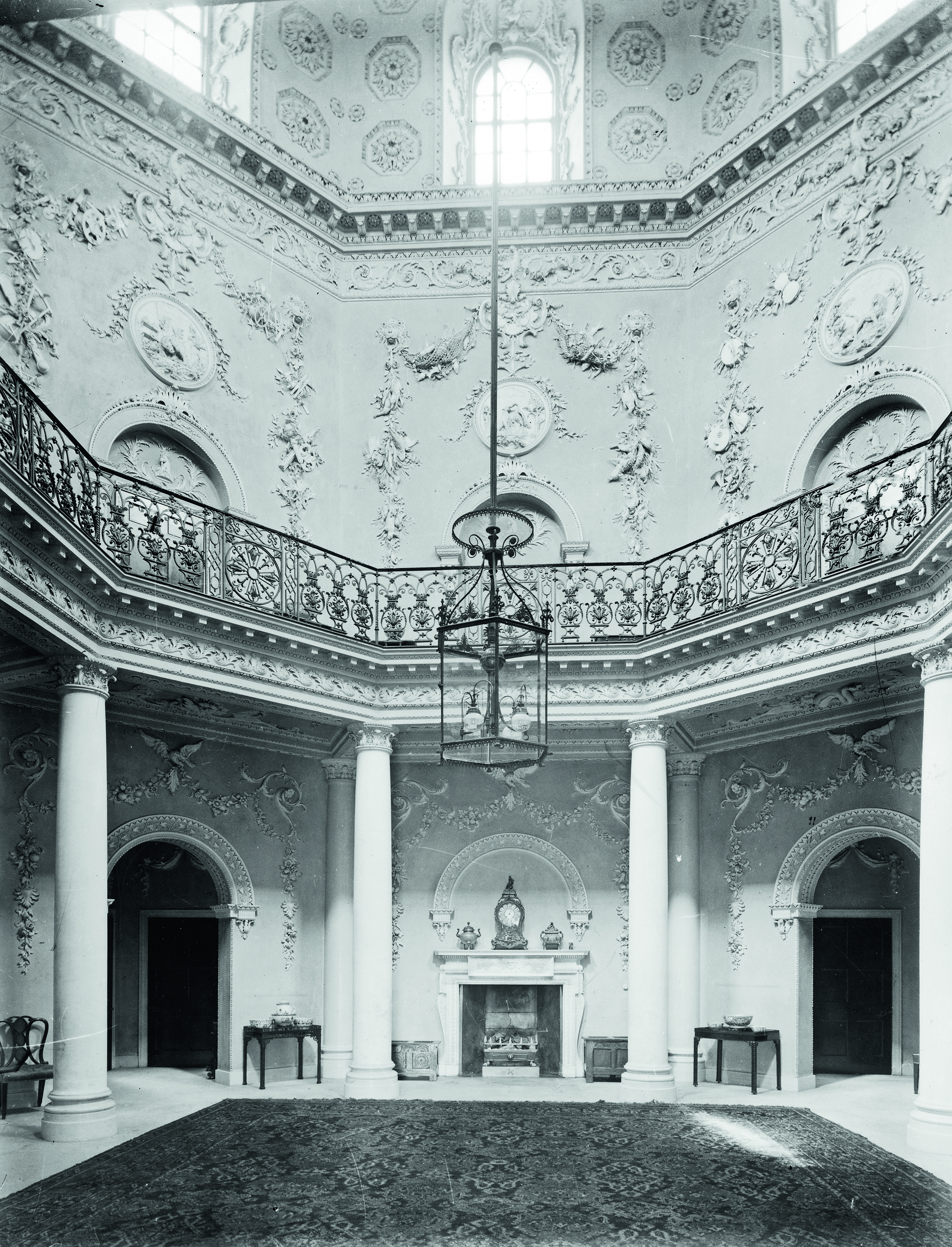Nuthall Temple: The Palladian masterpiece that was blown up to make way for the M1
Every Monday, Melanie Bryan, delves into the hidden depths of Country Life's extraordinary archive to bring you a long-forgotten story, photograph or advert.


Begun in 1754, and completed in 1757, Nuthall Temple was said to represent the finest Rococo work in England. A classical villa based upon Palladio’s design for Paolo Almerico’s villa at Capra, it featured a vast, octagonal hall festooned with ornate plasterwork.

Shortly before it was set alight, the interior fixtures and fittings were auctioned off. An advert for the forthcoming sale appeared in Country Life and used a photograph from the magazine’s archive to show the exceptional quality of the plasterwork in the Octagon Hall.
Considered the easiest of the four Palladian villas in England in which to live, and also possessing the prettiest gardens, like so many before and after it, the house succumbed to the inter-war period’s toxic trio of agricultural decline, high taxation, and decreasing control of traditional landowners. Attempts were made to save the Italianate building, with an advert placed in The Guardian on October 1, 1927 offering the property and land for sale with the vision for: ‘… a wonderful opportunity to create a Garden City’, complete with: ‘…trams, buses, electric light, gas and mains water' and offering Nuthall as: ‘…a fine old mansion, suitable for a club house, hotel etc’.
It was not to be, however. Just a month later, the estate was split into lots for sale, with sale of the furniture and contents coming in early 1928. The (almost) final nail in the coffin came with a full-page advert in Country Life — illustrated, somewhat ironically, with one of our architectural photographs — for the remaining fixtures and fittings, including the plasterwork in the aforementioned octagonal hall, to be auctioned off ahead of demolition. One Mr J. H. Brough of Beeston was put in charge of the demolition, with a piece in the Lincolnshire Echo on August 1, 1929, excitedly describing his new, more efficient form of destruction. Having underpinned parts of the house, ‘the woodwork was saturated with petrol and paraffin, and when it was ignited there was a tremendous blaze. Very soon the great wall and masonry, weighing about 400 tons, crashed’. It was further noted that Brough’s new method meant that eight week’s work could be completed in eight days, with the loss of woodwork (purists, cover your eyes now) more than compensated for by the saving in labour costs.
This was not quite the end of the house’s somewhat ignominious demise, however. Brough’s inflammatory method had not completely destroyed the rotunda, nor parts of the wings, which stood in ruins for the following 30 years until they, too, succumbed to progress. The shattered hulk suffered a final indignity by being blown up to make way for the M1 motorway in the 1960’s. Her remaining remains rest beneath the J26 southbound slip road.
The Country Life Image Archive contains more than 150,000 images documenting British culture and heritage, from 1897 to the present day. An additional 50,000 assets from the historic archive are scheduled to be added this year — with completion expected in Summer 2025. To search and purchase images directly from the Image Archive, please register here
Exquisite houses, the beauty of Nature, and how to get the most from your life, straight to your inbox.
Melanie is a freelance picture editor and writer, and the former Archive Manager at Country Life magazine. She has worked for national and international publications and publishers all her life, covering news, politics, sport, features and everything in between, making her a force to be reckoned with at pub quizzes. She lives and works in rural Ryedale, North Yorkshire, where she enjoys nothing better than tootling around God’s Own County on her bicycle, and possibly, maybe, visiting one or two of the area’s numerous fine cafes and hostelries en route.
-
 A vineyard for sale on the slopes above 'the best beach in Britain' is for sale at just £650,000
A vineyard for sale on the slopes above 'the best beach in Britain' is for sale at just £650,000In the beautifully unspoilt Devon village of Bantham, an award-winning vineyard is for sale. Toby Keel takes a look.
-
 The sun will come out for the Country Life Quiz of the Day, November 14, 2025
The sun will come out for the Country Life Quiz of the Day, November 14, 2025Try your luck at today's quiz.
-
 Only a handful of Britain's great houses were photographed by Country Life in a ruinous state. This once splendid Gothic castle is one of them
Only a handful of Britain's great houses were photographed by Country Life in a ruinous state. This once splendid Gothic castle is one of themThis is the tragic tale of Tong Castle, a once great Georgian-Gothic castle that was eventually consumed by Nature.
-
 The Rococo jewel nestled into vineyard terraces that's a visual index of 'a king’s Enlightenment belief in knowledge, cultivation and the civilising power of Nature'
The Rococo jewel nestled into vineyard terraces that's a visual index of 'a king’s Enlightenment belief in knowledge, cultivation and the civilising power of Nature'A summer picnic in 1743 prompted Frederick the Great to create a retreat for himself outside his capital at Berlin. The result was the creation of Schloss Sanssouci in Brandenburg, as Aoife Caitríona Lau explains.
-
 Best in class: This year's Georgian Group Architectural Award winners revealed
Best in class: This year's Georgian Group Architectural Award winners revealedThe Georgian Group’s Architectural Awards, sponsored by Savills, attracted another outstanding crop of entries this year. We reveal the winners, as chosen by a panel of judges chaired by Country Life's Architectural Editor, John Goodall.
-
 The rise, fall, rise and eventual demolition of a Welsh wonder with an intriguing link to the Duke of Westminster
The rise, fall, rise and eventual demolition of a Welsh wonder with an intriguing link to the Duke of WestminsterMelanie Bryan delves into the Country Life archives and the history of one of Wales’s most extraordinary manor houses.
-
 Exclusive: The House of Commons as you've never seen it before, 75 years on from reopening following its destruction during the Blitz
Exclusive: The House of Commons as you've never seen it before, 75 years on from reopening following its destruction during the BlitzThis year marks the 75th anniversary of the reopening of the House of Commons following the destruction of its predecessor in 1941 during the Blitz. John Goodall reports; photographs by Will Pryce.
-
 'A bluff, honest man in the trappings of greatness': The extraordinary story of the Foundling Hospital, and the sailor who saved the abandoned children of London
'A bluff, honest man in the trappings of greatness': The extraordinary story of the Foundling Hospital, and the sailor who saved the abandoned children of LondonA remarkable charitable endeavour to save abandoned children on the streets of London has a touching legacy in the form of the The Foundling Museum in the very centre of London. John Goodall tells its story; photographs by Will Pryce.
-
 Where is 'The Traitors' filmed? Inside the Scottish castle sold via the pages of Country Life three times for an unbelievable amount
Where is 'The Traitors' filmed? Inside the Scottish castle sold via the pages of Country Life three times for an unbelievable amountMelanie Bryans delves into the Country Life archives and uncloaks the history of the turreted Highland castle made famous by the global TV franchise, 'The Traitors'.
-
 Stefan Pitman: Making great country houses cost less to heat than a suburban semi
Stefan Pitman: Making great country houses cost less to heat than a suburban semiThe trailblazing architect Stefan Pitman — founder of SPASE — joins the Country Life Podcast.
